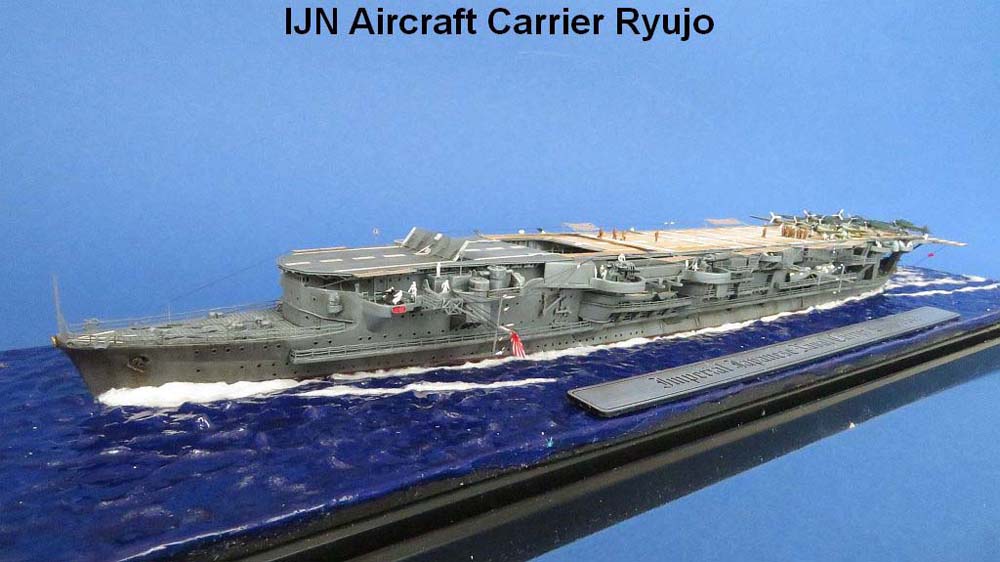
1/700 IJN Ryujo 1942 (Aoshima)
|
by Christian Hoeltge |

1/700 IJN Ryujo 1942 (Aoshima)
The Ryujo was a light carrier of the Japanese navy. It was an attempt to use a loophole in the Washington Fleet Treaty, in which aircraft carriers have a displacement of at least 10,000 tons. Accordingly, the Ryujo was planned with a displacement of 8000 t in order not to be considered as a aircraft carrier. After the lay down on 29 November 1929, this loophole was closed at the London Fleet Treaty in 1930. Accordingly, the Ryujo remained the only attempt to build such a light aircraft carrier. In order to achieve this, no armor was used. Originally she was planned with only one hangar deck. During the construction, the aircraft capacity was increased to 48 units, and a second hangar was added on the forst one. This and the narrow keel, however, led to a strong top-heaviness of the ship. The launch was on 2 April 1931 and the commissioning took place on 9 May 1933. Ayear later the torpedo boat Tomozuru sunk due to too much top-heaviness, and so all ships were checked for this weakness. The Ryujo was then rebuilt for the first time. Two of the originally six 12.7cm AA guns were removed and replaced by two twin 25mm AA guns. Also the keel was reinforced and ballast was added to increase the stability. However, one year later, in 1935, the Ryujo was one of the many ships that was heavily damaged during a typhoon. And so the Ryujo under took its second conversion. There, the foredeck was increased by a deck and the bridge was rounded. The Ryujo was then used to test new aircraft and tactics.The first combat action follows in August 1937, where the Ryujo, together with the Hosho, flew air attacks against Chinese troops.
Before the start of the Second World War the aircraft were replaced by twelve Mitsubishi Type 96 A5M4 "Claude" fighter aircraft and fourteen Nakajima Type 97 B5N "Kate" torpedo planes. Because of the too small rear lift, no D3A "Val" bombers could be used. With the beginning of the second world war in the Pacific on December 6, 1941, the Ryujo participated in the operation "M", the occupation Philippines. The attack on Singapore followed in February 1942. In May 1942 the "Claude" fighter aircraft were replaced by twelve Mitsubishi Type 0 A6M2 "Zero". With these new aircrafts, the Ryujo took part in the operation "AL", the occupation of the Kuriles. On July 13th, she returned to Kure for an overhaul. There the armament was brought up to date. The six 13mm quadruple AA guns was replaced by 25mm triple AA guns. The already installed 25mm twin guns remain.
After the Americans landed on the 7th of August 1942 in Guadalcanal, the Ryujo was sent together with the Shokaku and Zuikaku for a counter-attack to the Eastern Salomon Islands. The carrier aircrafts consists now of nine B5N2 "Kate" bombers and 24 A2M6 "Zero" fighter aircraft. On August 24th, the fleet reached the Eastern Salomon Islands, and at 11:20 am an attack on the Henderson airfield six B5N2 and five A6M2 were launched. At 12:48, another nine A6M2s followed. However, the aircraft achieved only minor damage to the airfield and with a loss of four B5N2 and 3 A6M2, only two F4-F "Wildcat" could be shoot down. The Ryujo was then attacked by aircraft of the USS Saratoga at 1:57 pm. The attack consisted of 30 SBDs and eight TBFs. Since only one TBF could be shoot down, the Ryujo received four direct bomb hits and a torpedo hit. Because of the torpedo hit she got very fast a list and the machines stopped very quickly. At 15:15 the abondant of the ship was arranged. The crew was taken by the destroyer Amatsukaze. After the survivors had left the ship, the Ryujo sank with the loss of 120 officers and sailors.
The kit comes from the company Aoshima. The kit is available in several versions, I used the limited edition of the kit with the flight deck made of clear plastic. For this I bought also the appropriate etching set of Aoshima, where also a wooden deck included. However, Tetra Model Works brought out a complete etch kit and an additional one for the flight deck. This brought much more details like new platforms and AA stands. The set for the flying deck also shows the struts at the bottom and a wooden deck is also included. So I used from the Aoshima set only a few handrails that were missing at Tetra Set. Otherwise, the construction ran smoothly. The accuracy of the Aoshima kit was very good. To this there came the excellent set of Tetra, which I had a lot of fun using it. It was very easy to work with it, but it could have be a bit more fine here and there. However, working with it would become more difficult than. It should be noted that the set does not have any parts for the launches, armament and aircrafts.
That's why I have also used:
My model is in preparation for the attack on the Henderson airfield where the first wave aircraft are being prepared. The model is painted with Tamiyas Kure Gray. I left the wooden deck like it was, and just added only a light washing. The flight deck was also lightened with dry brushing in the middle. The flight deck markings were sprayed, which also happened almost without subtracting the color. The water was done as usual with the Water Effects of Vallejo. For the waves I used again cotton in the water surface
- 25 mm twin and triple AA guns, anchor from Flyhawk
- Fivestar parts for the launches
- Ocean Spirit 12.7 cm AA guns
- Lion Roar aircraft and Flyhawk etch parts
- Pilotfiguresfrom Northstar models
- Sailor and binoculars from Shelf Oddity
